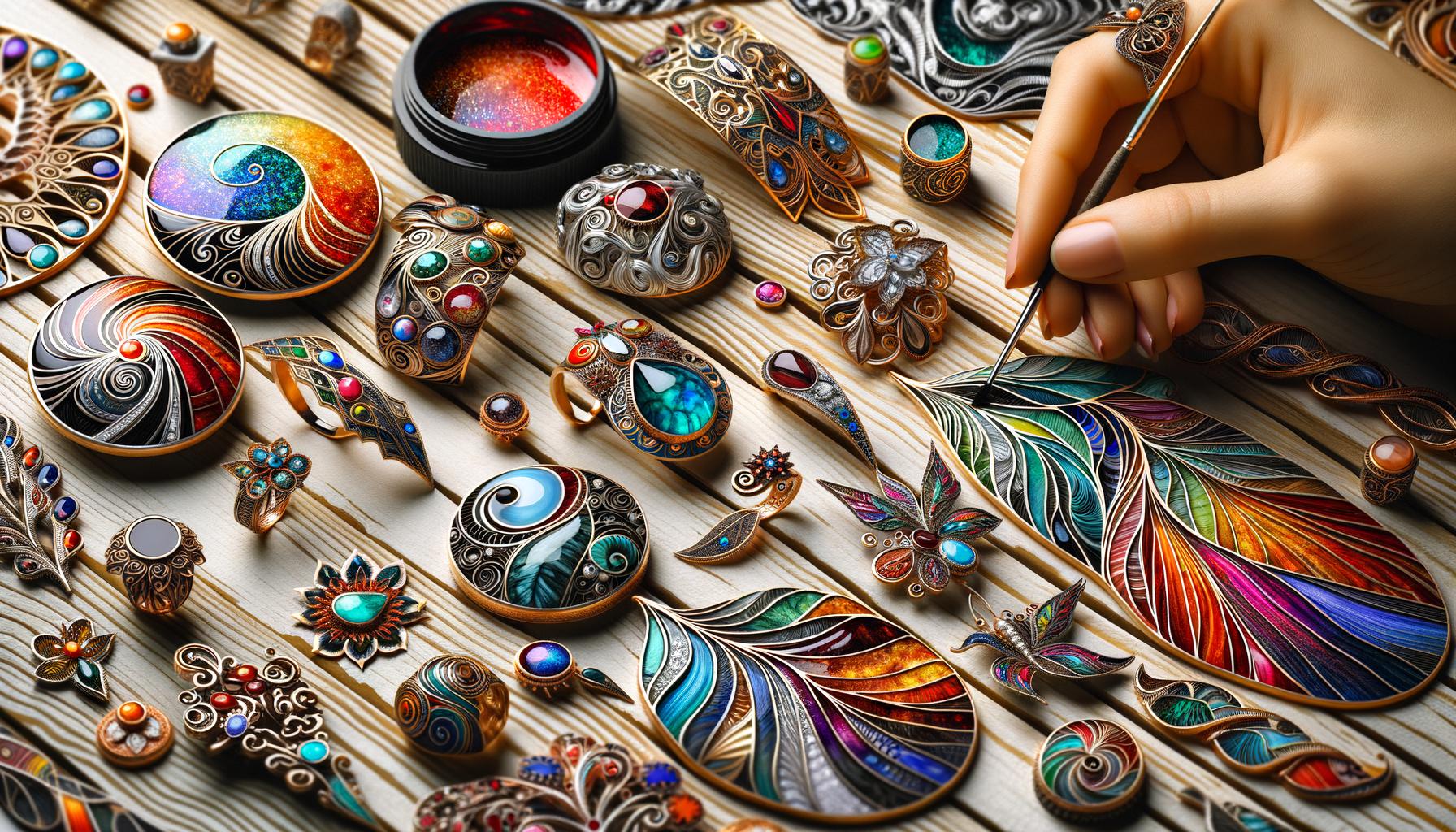Exploring enameling techniques for colorful jewelry designs opens up a world of vibrant possibilities in the realm of artistic adornments. Enameling, the process of fusing powdered glass to metal, has been cherished by jewelers for centuries due to its ability to introduce rich colors and intricate patterns into their creations. As one of the most versatile and captivating mediums within jewelry making, enameling allows designers to experiment with textures, hues, and effects that are otherwise unachievable through traditional metalworking alone.
Enameling is not simply an embellishment; it’s a fundamental technique that brings life and character to jewelry pieces. By incorporating enamel, artisans can produce stunning contrasts and eye-catching focal points that enhance both the aesthetic appeal and value of their work.
Whether you are drawn toward classic elegance or modern whimsy in your jewelry designs, mastering various enameling methods can radically transform your creative output. For anyone with a passion for crafting colorful jewelry, understanding these techniques will enrich their artistry and forge a deeper appreciation for this time-honored craft.
In this blog post, readers will embark on an informative journey through the vibrant world of enameling in jewelry design. From exploring its historical roots and cultural significance to delving into specific techniques such as cloisonné, champlevé, plique-à-jour, and torch-fired enameling-this guide aims to equip enthusiasts with both knowledge and inspiration.
Alongside detailed descriptions of methods and materials, safety tips will be provided to ensure that readers can enjoy their enameling adventures responsibly. Whether you are an experienced jeweler looking to expand your repertoire or a curious beginner eager to learn new skills, this comprehensive guide promises valuable insights into creating extraordinary enameled jewelry pieces.
The History of Enameling in Jewelry
Origins and Evolution of Enameling Techniques
The art of enameling dates back thousands of years, with origins tracing to ancient civilizations such as the Egyptians, Greeks, and Chinese. These early artisans discovered that by fusing powdered glass to a metal substrate through high-temperature firing, they could create intricate and durable designs.
This discovery not only allowed for colorful decoration but also served practical purposes by protecting metal surfaces from corrosion. Over time, various societies refined their techniques, leading to the development of multiple styles and methods that are still used today.
As technology advanced over the centuries, so did the complexity and beauty of enamel work. The Byzantine Empire became known for its cloisonné enamels during the 6th century-ornate pieces where colored glass was set within thin metal partitions. Meanwhile, in medieval Europe, champlevé emerged as a popular technique where troughs or cells carved into a metal object were filled with enamel. Each region had its unique approach, contributing richly to the global tapestry of enameling craftsmanship.
Cultural Significance and Regional Variations
Enameling techniques were not just preserved for their aesthetic values; they held significant cultural importance across different eras and locales. In ancient Egypt, enamel was often used in jewelry worn by royalty and deities depicted in wall art-symbolizing power and divine protection. The Chinese took a special interest in cloisonné during the Ming Dynasty (1368-1644), using it to adorn everything from vases to architectural features with intricate designs featuring symbolic meanings.
Japan’s contributions to enameling cannot be underestimated either; Japanese artists developed “shippo” or Japanese cloisonné during the Edo period (1603-1868), known for its translucent quality and vibrant colors. Each culture adapted basic enameling concepts uniquely according to available materials and local artistic traditions. Like an ever-evolving language, exploring enameling techniques for colorful jewelry designs reveals a fascinating story etched through time.
Famous Historical Pieces That Used Enameling
Throughout history, numerous masterpieces have showcased the remarkable versatility of enameling techniques. One such example is the Fabergé eggs created by Russian goldsmith Peter Carl Fabergé between 1885 and 1917 for Russia’s Imperial family. Known for their elaborate cloisonné detailing combined with precious metals and gemstones, these eggs epitomize luxury and craftsmanship at its finest.
Another iconic example includes The Crown Jewels of Iran housed at Tehran’s National Jewels Museum which prominently features enamel work from various Persian dynasties showcasing exceptional workmanship integrated into royal regalia. Such pieces do more than decorate-they tell stories about power dynamics, cultural exchange, patronage systems among royalty across continents.
Whether found on an ornate piece from medieval Europe or an ancient artifact unearthed in China or Egypt-enameled pieces throughout history capture human creativity transcending borders while leaving a luminous legacy behind them for future generations exploring enameling techniques for colorful jewelry designs.
Types of Enameling Techniques
Enameling techniques are varied and each brings its own unique flair to the world of jewelry design. By exploring enameling techniques for colorful jewelry designs, artisans and hobbyists can add vibrant hues and intricate patterns to their creations. This section will delve deep into some of the most popular methods used in the field, shedding light on their distinct characteristics and applications.
Cloisonné Enameling
One of the oldest and most revered enameling methods is cloisonné. This technique involves creating compartments, or “cloisons,” using thin metal wires which are then filled with enamel powder. The piece is fired multiple times to fuse the enamel within these partitions. Originating from ancient Byzantine and Egyptian cultures, cloisonné has stood the test of time due to its ability to produce mesmerizing, intricate designs that emulate stained glass windows.
Champlevé Enameling
Unlike cloisonné which builds up from a flat surface, champlevé incorporates recesses into a metal base that are then filled with enamel powder. These recesses are usually carved or etched out, providing depth and texture to the jewelry piece. Champlevé offers a more tactile experience when exploring enameling techniques for colorful jewelry designs because it allows for raised borders that beautifully contrast against vibrant sections of enamel within them.
Plique-À-Jour Enameling
Plique-à-jour is another captivating method that resembles miniature stained glass windows; however, it requires no backing behind the colored enamel sections. Translated as “letting in daylight,” this technique involves filling pre-made wire frameworks with translucent enamel so light can pass through them fully, giving a luminous effect akin to delicate filigree work infused with color.
Torch-Fired Enameling
Torch-fired enameling is particularly well-suited for beginners due to its accessibility and simplicity compared to kiln firing methods. Using a handheld torch instead of a kiln allows artists greater control over heat application-and therefore color quality-while keeping production costs relatively low. With just a few basic tools like butane torches and trivets along with standard safety measures, you can quickly experiment with bold colors on small jewelry pieces without investing in expensive equipment rights away.
Exploring these diverse enameling techniques opens doors to an array of creative possibilities when designing colorful jewelry pieces tailored both by technique preference as well as desired visual outcomes stemming from each method’s intrinsic properties.
Cloisonné Enameling
Cloisonn enameling, one of the oldest enameling techniques known to mankind, has been celebrated for its intricate and colorful results. Dating back to ancient cultures such as Egypt and China, cloisonn has earned a revered spot in jewelry making due to its ability to create stunning designs with vibrant hues. Exploring enameling techniques for colorful jewelry designs like cloisonn allows artists to encapsulate their creativity within delicate metal frameworks.
To begin, the cloisonn technique involves partitioning a metal surface into distinct sections using thin strips of wire, usually made from metals like gold or copper. These partitions create small compartments, or cloisons, which are then filled with enamel powders.
The choice of wire material can affect both the aesthetics and durability of the finished piece. Essential tools include a jeweler’s pliers for shaping wires, a kiln for fusing the enamel powder onto the base metal, and a variety of polishing materials to achieve that final glossy finish.
The step-by-step process starts by designing and sketching your intended pattern onto the metal base. Once your design is ready, you will use wire to create outlines on your piece according to your sketch. After adhering the wire securely-which does require some precision-the next step is filling those compartments with enamel powders using fine brushes or sifters.
Each color typically necessitates multiple firings at high temperatures within a kiln until all layers are completely fused and vibrant colors emerge vividly. Finally, polishing ensures a smooth surface that enhances both brilliance and durability.
| Key Component | Description |
|---|---|
| Wire Material | Gold or Copper |
| Kiln | Used for firing and fusing enamel powder |
| Polishing Tools | For achieving glossy finish on completed piece |
| Cloisons | Partitions created by wire on the metal base |
Embracing cloisonn enameling provides not only an opportunity for artistic expression but also links contemporary jewelry makers with timeless traditions practiced over millennia. Whether you’re an experienced jeweler or just stepping into exploring enameling techniques for colorful jewelry designs, cloisonné offers exciting possibilities for creating detailed and lasting pieces that captivate admirers’ eyes with their unmatched beauty.
Champlevé Enameling
Explanation of Champlevé Technique
Champlevé, French for “raised field,” is an enameling technique where recessed areas are carved or etched into the surface of a metal object. These recessed areas are then filled with enamel powder and fired until the enamel melts and fuses to the metal.
Once cooled, the surface is polished flat, revealing vibrant colors contrasted against the metal’s lustrous sheen. This method creates depth and texture in jewelry, allowing artists to play with three-dimensional designs that catch light differently at various angles.
Suitable Base Materials and Tools
When exploring enameling techniques for colorful jewelry designs, it’s essential to consider suitable base materials for champlevé. Copper and silver are popular choices due to their excellent ability to hold detailed carvings and high melting points that withstand multiple firings.
Essential tools include gravers or etching equipment for creating precise recesses, brushes for applying enamel powders, and kilns equipped with temperature control to ensure even firing – critical for achieving consistent results. Artists often use additional polishing tools like diamond files or sanding sponges to smooth the surface once the piece is completed.
Creating Textured and Recessed Designs With Champlevé
To create textured and recessed designs using the champlevé technique, begin by sketching your design onto a metal sheet. Next, carefully carve out your patterns using gravers or etching acid if you’re working with a more intricate design requiring fine lines. After cleaning the piece thoroughly to remove any grease or residue – which could affect how well the enamel adheres-apply your chosen enamel powders into recessed areas.
Multiple firings may be necessary if you’re aiming for complex coloration or gradient effects. Post-firing involves polishing the piece until it reaches a smooth finish where only raised metal sections remain untouched by enamel, offering a tactile dimension that enriches overall aesthetics.
By mastering these subtleties in champlevé enameling, jewelers can achieve stunning pieces that exhibit both visual complexity and rich texture-hallmarks of exquisite craftsmanship in exploring enameling techniques for colorful jewelry designs.
Plique-À-Jour
To create plique-à-jour jewelry, you will need several specialized tools and materials. Essential items include fine silver or gold wire for the framework, high-quality transparent enamels, a kiln for firing the enamels at precise temperatures, and various hand tools like tweezers and files for shaping and smoothing the framework.
The process begins by fashioning delicate openwork designs with wires that form cells to hold the enamel. Once the framework is ready, finely ground enamel powders are carefully placed into each cell.
Achieving success with plique-à-jour requires patience and precision during both application and firing stages. As you continue exploring enameling techniques for colorful jewelry designs, ensure that each layer of enamel is fired individually to avoid collapsing cells or cracking due to uneven expansion.
Examples of inspiring plique-à-jour designs include intricate floral patterns, abstract geometric shapes, and even depictions of natural scenes like birds or butterflies. Not only do these pieces exhibit exceptional artistry, but they also capture and reflect light in mesmerizing ways.
| Tool | Purpose |
|---|---|
| Fine Silver/Gold Wire | Create framework cells for holding enamel |
| High-Quality Transparent Enamels | Provide vibrant and translucent colors |
| Kiln | Precisely fire layers of enamel at correct temperatures |
| Tweezers & Files | Shape and smooth openwork designs |
Design inspiration can be found throughout art history as well as modern interpretations of stained glass windows. Famous examples include Art Nouveau pieces crafted by renowned jewelers like René Lalique who extensively used plique-à-jour to create breathtaking jewelry portraying nature themes. By mastering this technique and incorporating it into your work, you’ll not only develop an appreciation for traditional craftsmanship but also push creative boundaries in your own jewelry designs.
Torch-Fired Enameling
To start with torch-fired enameling, you’ll need some basic tools and materials: copper or other suitable metal blanks, powdered enamel in various colors, a hand-held torch, trivets, mesh screens, and tongs. Begin by prepping your metal piece-cleaning it thoroughly to remove any oils or dirt that could affect adhesion.
Next, apply an adhesive like Klyr-Fire to help the powder enamel stick before heating. Remember to wear appropriate safety gear such as protective glasses and gloves since torch-firing involves direct exposure to high temperatures.
Once your material is prepped and ready, place the metal piece on a trivet over a mesh screen for support. Apply the powdered enamel evenly across the surface before using your torch to carefully heat it from below or above until it melts and fuses smoothly onto the metal base.
This process typically requires maintaining steady hands as you maneuver the flame; too much heat can cause over-firing while not enough will under-fire the piece. With practice and patience, however, torch-fired enameling can yield stunning results with bright colors that rival those achieved by more traditional methods.
| Tools | Materials |
|---|---|
| Hand-held Torch | Metal Blanks (Copper) |
| Trivets & Mesh Screens | Powdered Enamel |
| Tongs | Klyr-Fire Adhesive |
Safety Tips for Enameling
When exploring enameling techniques for colorful jewelry designs, ensuring the safety of your workspace and personal well-being is crucial. One of the most important aspects to consider is proper ventilation. Enameling involves working with powdered glass and sometimes potentially toxic chemicals, which can produce harmful fumes when heated.
Hence, it’s essential to set up your workstation in a well-ventilated area or use a fume hood. Avoiding inhalation of these fumes will prevent respiratory issues and other health problems.
Personal protective equipment (PPE) is another critical aspect of safe enameling practice. When handling enamels and working at high temperatures, it’s prudent to wear:
- Safety goggles or a face shield to protect your eyes from flying particles.
- Heat-resistant gloves to prevent burns.
- A dust mask or respirator when sifting enamel powders or cleaning fired pieces.
These precautions are not just recommendations; they are vital practices for maintaining safety during each enameling session.
Adding on, the safe handling and storage of chemicals and materials are paramount. Keep all enamels, acids, and other chemicals clearly labeled and stored in tightly sealed containers away from children or pets. Maintain cleanliness by regularly sweeping your workspace to avoid contamination between colors that can compromise the quality of your work. Always have a designated place for each tool and material to avoid accidents caused by cluttered workspaces.
Lastly, when working with kilns or torches-common tools in many enameling processes-it’s crucial to respect their power through rigorous adherence to safety guidelines. Never leave the kiln unattended while it’s operating. Keep flammable materials far from your heat sources, and always allow plenty of time for pieces-and your kiln-to cool down before handling them directly.
By incorporating these safety tips into your routine while exploring enameling techniques for colorful jewelry designs, you ensure not only the consistent quality of your work but also maintain a safer creative environment that allows you to focus on producing stunning jewelry pieces without compromising health and safety standards.
Selecting the Right Enamel and Metal
When choosing metals for enameling, it’s important to consider their compatibility with your selected enamels. Metals such as copper, fine silver, and gold are often preferred due to their excellent adhesion properties with enamel powders. Copper is particularly popular among beginners due to its affordability and ease of use.
Fine silver offers a high-end finish and is less prone to oxidation during the firing process. Gold provides luxury but comes with a higher price tag; thus it’s often reserved for special or high-value projects.
To ensure successful outcomes in your enameling endeavors, keep these tips in mind:
- Test Compatibility: Always perform small test patches when trying new combinations of enamel and metal.
- Surface Preparation: Ensure that the metal surface is clean and free from oils or contaminants before applying enamel.
- Firing Process: Properly regulate the kiln or torch temperatures suitable for both the chosen metal and enamel types.
By selecting the appropriate materials thoughtfully and understanding their interactions, you can produce stunning enameled jewelry that stands out in both appearance and craftsmanship.
Troubleshooting Common Enameling Issues
When exploring enameling techniques for colorful jewelry designs, encountering issues such as cracking, under-firing, or contamination can be frustrating. However, understanding the root causes and solutions to these problems can significantly improve the quality of your work. Cracking often occurs when there is an imbalance in cooling rates between the metal base and enamel. To prevent this, ensure your pieces cool gradually and uniformly. Using compatible enamels with your chosen metal substrate also helps minimize stress-induced fractures.
Under-firing is another common problem where the enamel doesn’t achieve a smooth glassy finish or appears gritty and matte. Ensuring that your kiln temperature is accurate and consistent is crucial for proper firing. Investing in a reliable pyrometer and regularly calibrating your kiln can make a significant difference.
Additionally, each type of enamel has its specific firing temperature range; adhering to these guidelines helps achieve optimal results. For artists who use torch-fired enameling-which tends to be more accessible yet variable-monitoring flame intensity and duration carefully is key.
Contamination can manifest through discoloration or specks within the enamel layer, caused by impurities from tools, work surfaces, or previous applications on the same piece. Maintaining a clean workspace is essential; using dedicated tools for enameling and thoroughly cleaning them before each use prevents unwanted debris from embedding into the enamel layers. Always wash metal bases meticulously before applying any new coats of enamel to avoid any residual contaminants affecting your final outcome.
To achieve a smooth and consistent finish across various projects:
- Use fine-grade sifted enamels: This reduces uneven application.
- Apply even enamel layers: Both thin spots and over-application can lead to imperfections.
- Eliminate air bubbles: During sifting or shaking off excess powder.
Incorporating repairs seamlessly into colored jewelry pieces often requires patience and precision undetectable touch-ups can be made with delicate re-firing or adding small amounts of fresh enamel powder followed by controlled heating sessions.
By addressing these common issues head-on, jewelers can produce stunning pieces with confidence while continuing their journey of exploring enameling techniques for colorful jewelry designs without unnecessary setbacks.
Showcasing Your Work
Mastering the art of showcasing your enameled jewelry is crucial in capturing the attention of potential buyers and admirers. The key to effective presentation lies in high-quality photography, which should accurately highlight the intricate details and vibrant colors of your pieces. Begin by investing in a good camera or using a modern smartphone with a high-resolution camera.
Utilize natural light for the best results, as it brings out the true hues of your enameling. A macro lens can be particularly useful for capturing close-up shots that reveal the finer aspects of your work.
For those exploring enameling techniques for colorful jewelry designs, consider creating an inviting visual narrative around your pieces. Use props and backgrounds that complement but do not overshadow your jewelry. For example, neutral or softly textured backdrops often work well to emphasize the jewel tones and delicate craftsmanship of enameled items. Experiment with different angles to showcase various facets of your creation; sometimes, an overhead shot might capture the essence better than a straight-on view.
Sharing your work on social media platforms like Instagram, Pinterest, and Facebook can significantly boost exposure. Pay attention to trends within each platform’s community by using popular hashtags relevant to jewelry design and enameling.
Creating short video clips or time-lapse videos demonstrating parts of your process can also engage viewers more deeply than static images alone. Lastly, don’t underestimate the power of well-written captions-describe your inspiration, technique used, and any unique aspects of the piece that might intrigue potential customers or fellow enthusiasts.
Conclusion
Exploring enameling techniques for colorful jewelry designs opens a world of creativity and craftsmanship that is deeply rooted in both history and modern innovation. From the ancient art forms like cloisonné and champlevé to more accessible methods like torch-fired enameling, there is a technique suited for every skill level and artistic vision. Each method offers unique opportunities to bring vivid colors and intricate details to metal surfaces, transforming simple materials into stunning pieces of wearable art.
Experimenting with different enameling techniques can be incredibly rewarding, whether you’re a seasoned jeweler or just beginning your journey into this fascinating field. Cloisonné’s detailed wirework, champlevé’s textured depths, plique-à-jour’s stained-glass effect, and the quick, vibrant results of torch-fired enameling each provide distinct avenues for expression.
As you delve into these techniques, don’t be afraid to try new methods and combine various approaches to discover what works best for your creative ideas.
For those interested in further developing their skills, numerous resources are available to guide you through more advanced aspects of enameling. Online tutorials, workshops, community forums, and local classes can offer additional insights and support.
Engaging with a community of fellow enamel enthusiasts can also provide inspiration and valuable feedback as you continue exploring this versatile and beautiful form of jewelry design. Ultimately, the joy lies in the process as much as in the final creation-so embrace the learning curve and let your imagination lead the way.
Frequently Asked Questions
Which of the Enameling Techniques Is the Most Difficult?
Plique-à-jour is often considered the most difficult enameling technique due to its complexity and the skill required. This method involves creating a stained-glass effect without a metal backing to support the enamel, making it highly fragile and challenging to execute.
Achieving successful results requires precise control of heat and meticulous craftsmanship to ensure that the enamel remains intact while retaining its vibrant transparency.
What Are the Methods of Enameling?
There are several methods of enameling, each with unique characteristics and applications. These include cloisonné, which uses thin wires to create compartments filled with enamel; champlevé, where cells are carved into the metal surface before being filled with enamel; plique-à-jour, resembling stained glass; and basse-taille, involving low-relief metalwork under translucent enamel.
Each method requires specific skills and tools, resulting in diverse finishes and textures that contribute to the artistry of enameling.
How Do You Enamel Jewelry?
To enamel jewelry, one begins by preparing the metal surface through cleaning and potentially applying a base coat of flux. Next, powdered glass or specially formulated enamel is carefully applied using various techniques like sifting or painting. The piece is then fired at high temperatures in a kiln until the glass melts and fuses to the metal.
After cooling, finishing touches may be added through polishing or additional firings for complex designs. The entire process requires precision and patience to achieve stunning enameled jewelry pieces that boast both beauty and durability.

Welcome to my jewelry blog! My name is Sarah and I am the owner of this blog.
I love making jewelry and sharing my creations with others.
So whether you’re someone who loves wearing jewelry yourself or simply enjoys learning about it, be sure to check out my blog for insightful posts on everything related to this exciting topic!





